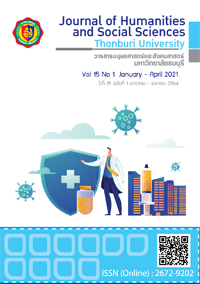Quality of Life of Children and Youths in Skipped Generation Families in Thailand’s Northeastern Region
Keywords:
Quality of Life, Children and Youths, Skipped Generation FamilyAbstract
This article aims to study the levels and factors of important quality of life of children and youths in skipped generation families in Thailand’s northeastern region. The study is mixed research comprising qualitative research and quantitative research. The data was compiled from the sample group of children and youths in top three provinces with the most skipped generation families in northeastern region of Thailand including Surin, Nong Bua Lamphu and Roi Et. The quality of life questionnaire is applied with 483 cases and in-depth interview is made with 15 cases. The results of quality of life questionnaire prove that the respondents have overall quality of life at moderate level (51 percent) and good level (48 percent). For each aspect, the quality of life in mental health is the best, followed by physical health, while quality of life in social relationship is less. Meantime, factor affecting quality of life of children and youths in all four aspects is that different persons giving money to children will result in different quality of life of children and youths. Besides, the results of interview show that the crucial elements of decent quality of life are family relationship and parents and guardian care which apparently affect to mental feeling.
References
กระทรวงสาธารณสุข. กรมสุขภาพจิต. (ม.ป.ป.). เครื่องชี้วัดคุณภาพชีวิตขององค์การอนามัยโลกชุดย่อ ฉบับภาษาไทย (WHOOL–BREF–THAI). สืบค้นเมื่อ 17 กรกฎาคม 2563, จาก https://www.dmh.go.th/test/whoqol/
กัลยา วานิชย์บัญชา. (2548). หลักสถิติ. กรุงเทพฯ: โรงพิมพ์แห่งจุฬาลงกรณ์มหาวิทยาลัย.
คาสปาร์ พีค; วาสนา อิ่มเอม; และ รัตนาภรณ์ ตังธนเศรษฐ์.(2558). รายงานสถานการณ์ประชากรไทย พ.ศ. 2558 โฉมหน้าครอบครัวไทยยุคเกิดน้อย อายุยืน. กรุงเทพฯ: กองทุนประชากรแห่งสหประชาชาติประจำประเทศไทย ร่วมกับสำนักงานคณะกรรมการพัฒนาการเศรษฐกิจและสังคมแห่งชาติ
เนื้อแพร เล็กเฟื่องฟู; และ ธัญมัชฌ สรุงบุญมี. (2562). มองบทบาทของสภาวะครัวเรือนแหว่งกลางต่อการพัฒนาคนผ่านฐานข้อมูล Longitudinal ของไทย. สืบค้นเมื่อ 8 พฤษภาคม 2563, จาก https://www.pier.or.th
พัฒนาพร ไทยพิบูลย์. (2560). แนวทางการส่งเสริมการเรียนรู้ของครอบครัวแหว่งกลางเพื่อส่งเสริมความอยู่ดีมีสุขของเด็กภายใต้ความคิดรอบครัวนิเวศ. วิทยานิพนธ์ครุศาสตรดุษฎีบัณฑิต. สาขาวิชาพัฒนศึกษา คณะครุศาสตร์. จุฬาลงกรณ์มหาวิทยาลัย.
วณิชชา ณรงค์ชัย และดุษฎี อายุวัฒน์. (2554). รูปแบบการอยู่อาศัยร่วมกันของคนข้ามรุ่นในครอบครัวผู้ย้ายถิ่นอีสาน. วารสาร มข.(ฉบับบัณฑิตศึกษา). 11: 101-110.
สำนักงานสถิติแห่งชาติ. (ม.ป.ป.). มองครอบครัวไทยในมุมมองของข้อมูล. สืบค้นเมื่อ 28 ตุลาคม 2562, จาก http://service.nso.go.th/nso/web/article/article_83.pdf
อารี จำปากลาย; กาญจนา ตั้งชลทิพย์;และ แครี่ ริคเตอร์. (2559). ผลกระทบของการย้ายถิ่นในประเทศที่มีสุขภาวะและพัฒนาการเด็กปฐมวัย: ผลการสำรวจพื้นฐานเชิงปริมาณและเชิงคุณภาพองค์การยูนิเซฟ.
อารี จำปากลาย; และคณะ. (2556). ลูกๆ เป็นอย่างไรเมื่อพ่อแม่ย้ายถิ่นโครงการ CLAIM. นครปฐม: สถาบันวิจัยประชากรและสังคม มหาวิทยาลัยมหิดล.
Translated Thai References
Champaklai, A., Tangcholtip, K.;& Rictor, C. (2016). Impacts of Migration in Country with Well-Being and Development of Childhood: Quantitative and Qualitative Survey Results.UNISEF. (in Thai)
Champaklai, C.; & et.al. (2013). How Children Be When Parents Migrate CLAIM Project. Nakhon Prathom: Institute for Population and Social Research Mahidol University. (in Thai)
Department of Mental Health. (n.d.). World Health Organization quality of life indicators, Thai version (WHOQOL-BREF-THAI). Retrieved July 17, 2020, from https://www.dmh.go.th/test/whoqol/ (in Thai)
Lekfuangfu, N.;& Srungboonme, T. (2019). Looking at the role of the middle and low household status in human development through the Thai Longitudinal Database. Retrieved May 8, 2020, from https://www. pier.or.th (in Thai)
Narongchai, W. and Ayuwat, D. (2011). Patterns of Co-resident of Skipped generation in Isan Migrant Family. Khon Kaen University Journal. (Graduate Study) 11: 101-110. (in Thai)
National Statistical Office. (n.d.). Viewpoint Towards Thai Family Based on Data. Retrieved October 28, 2019, from http://service.nso.go.th/nso/web/article/article_83.pdf. (in Thai)
Peak, Caspar; Im-Em, Wasana.; & Tungthanaset, Ratanaporn. (2015). Thai Population Report 2015: Low Birth Rate and Silver Age. Bangkok: The United Nations Population Fund and National Economic and Social Development Board. (in Thai)
Thaipiboon, P. (2017). Guideline for learning enhancement for skipped generation family to promote child well-being based on the family ecology framework. Doctor of Philosophy Thesis. Development Education Faculty of Education. Chulalongkorn University. (in Thai)
VanichBancha, Kanlaya. (2005). Statistical statistics. Bangkok: Chulalongkorn University Press. (in Thai)







